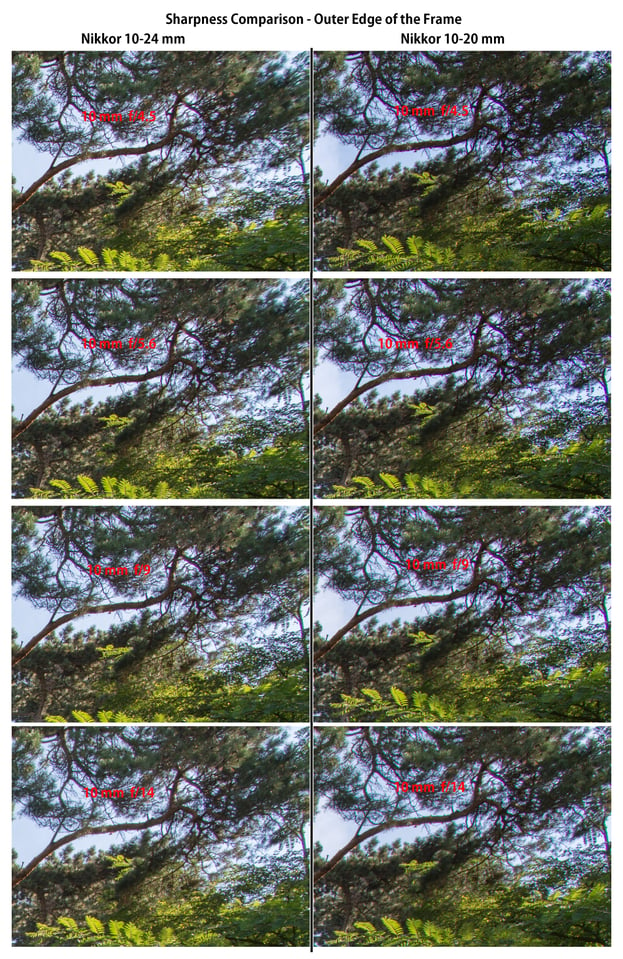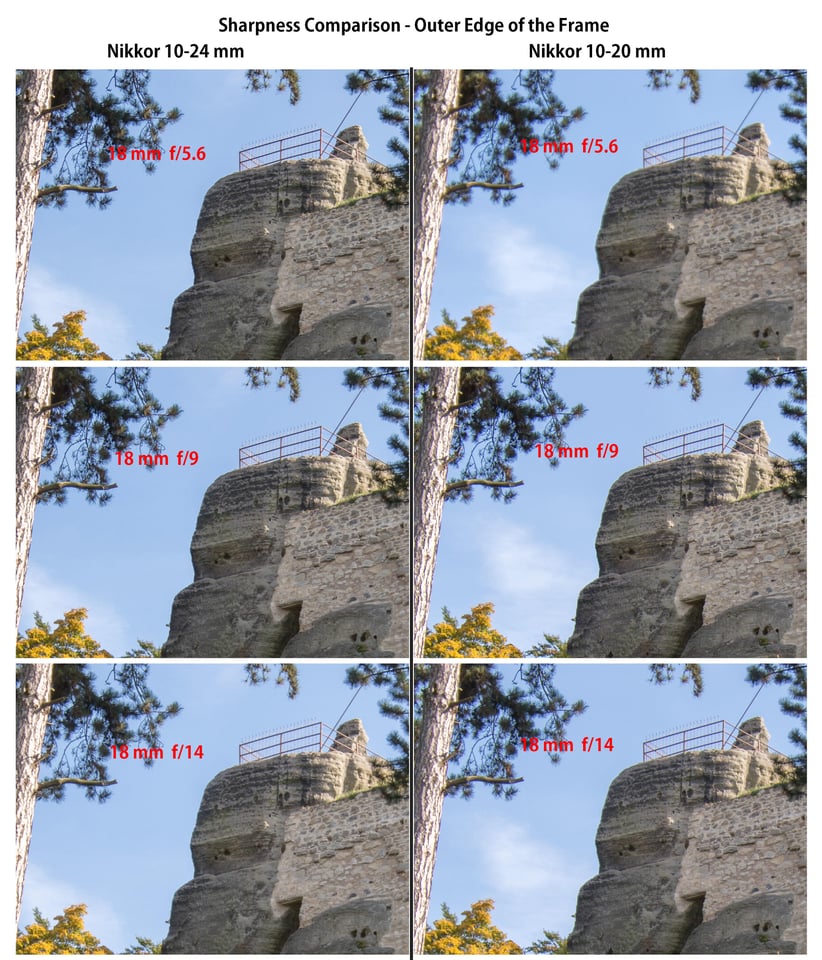Lens Sharpness and Contrast
When it comes to sharpness, this lens is decent to very good performer. I cannot offer any Imatest charts (that’s up to Nasim to produce), but judging from some 2,500 images taken in various conditions my conclusions are the following:
At 10mm, the displays a very even performance from wide open (f/4.5) up to f/14. This holds also for other focal lengths – such as 12, 14, 16 and 18mm. There, the sharpness across the whole frame is very good even wide open, peaking at around f/8 – f/11. The weakest performance is displayed at 20mm, where this lens is softer compared to other focal lengths. See below image crops for more details:
And here are the actual 100% crops:
I find the micro-contrast to be very good and color rendition rather neutral, without any color cast. It is quite important that the lens does not lose microcontrast transmission against sun (see the previous pages for more details).
Despite the weaker results at 20mm, it is still overall a very good performance. Take a look at the below image captured at 10mm, along with a 100% crop from the lower part of the image:


If are wondering about the MTF performance of the lens, take a look at the Nikon-provided MTF chart:

Lens Construction
And here is the optical construction of the lens:

Sharpness Comparison to Other Lenses
Based on the above crops, below is a summary of how the Nikon 10-20mm AF-P compares to other lenses that cover similar focus lengths from both Nikon and Tokina.
Nikon 10-20mm AF-P vs Nikon 10-24mm
The new Nikkor 10-20mm is (with the exception of 20mm) a very balanced performer. It performs very similar wide open and stopped down. This is a bit different behavior compared to the older 10-24mm lens, where the sharpness peaked stopped down a bit to above f/5.6 and then dropped when stopped down beyond f/9. I also see slightly better corner performance with the new 10-20mm at wide end (@10-12mm) although the improvement is very marginal. At 20mm the lens is noticeably softer compared to Nikkor 10-24mm in the range from f/5.6 to f/9. Only at f/14 the new 10-20mm can catch up.
Nikon 10-20mm AF-P vs Tokina 11-16mm
Tokina performs optically better at the same aperture values, which is not a surprise given the more limited focal range.
Nikon 10-20mm AF-P vs Nikon 20mm f/1.8G
This comparison is almost unfair. Nikkor 20mm is a fixed prime lens (FX) which is known for a stellar performance. The comparison is especially tough since Nikkor 10-20mm is weakest at 20mm. So when compared, as one can as expected see a significant difference in favor of the prime lens. Only when heavily stepped down to around f/14, the sharpness of the zoom lens approaches the results of the more expensive sibling.
Comparison with Other Lenses
In the past years, there has been a growing number of DX lenses available in the entry-level market segment. Sigma offers the 10-20mm f/3.5 EX DC HSM for 499 USD. For the higher price one gets the added advantage of the faster constant aperture. I could not compare the lenses directly, I could only compare it to the older Sigma wide-angle lens, which was tiny bit softer and much poorer in handling direct sunlight.

Tokina has even several DX options. Apart from the above mentioned excellent 11-16mm f/2.8 lens, there is also the newer 11-20mm f/2.8 AT-X PRO DX. For a higher price, it features an almost identical zoom range and much faster constant aperture, which makes it ideal for indoor shooting. Tokina also designed a first constant f/2.0 lens (Tokina AT-X 14-20mm f/2 Pro DX) but the 4mm difference puts it into a different category. In any case, neither of these competitors are as small or light as the Nikon. Most of them do not feature optical stabilization.
The most similar competitor hence seems to be the new Tamron 10-24mm f/3.5-4.5 Di II VC HLD. It is optically stabilized and it displays (according to some first reviews and feedback from my colleagues) an outstanding center sharpness. This lens is, however, currently priced at double the level of the Nikkor (499 USD versus 306 USD).
Table of Contents










